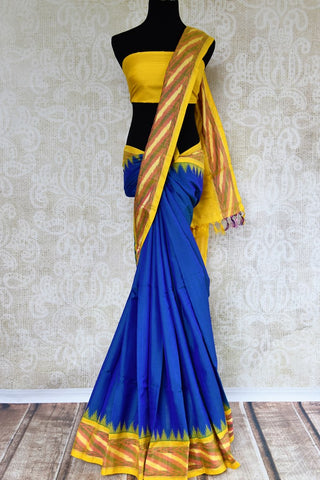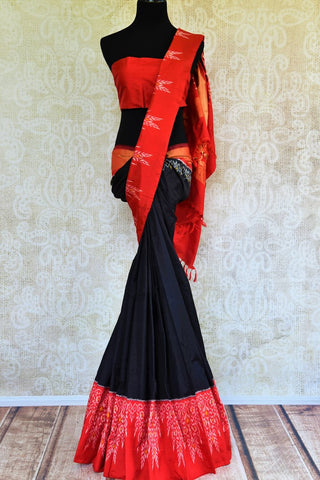The brilliant skill of Ikat weaves which is passed on through several generations has garnered prominent attention all across the world. Pochampalli Ikat which is quite popular amongst the women clan for their exquisite Ikat printed cotton and silk weaves has derived its name from a small town of Pochampally near Hyderabad in Andhra Pradesh. The art of weaving cotton and silk silhouettes with peculiar dyes of Ikat is believed to have been brought from the Chirala town to Pochampally. It was earlier called as “chit-ku” in Chirala.
While there are innumerable speculations regarding the origin of fabric which is believed to have been introduced by Dutch traders to Europe at the same time when the Spanish and Hispanics adopted the rare textile production through Silk Road. The word “Ikat” is coined from a malay-Indonesian term called “tie.” Ikat manufacturing process dates back to 1970 when the Pochampally weavers embraced silk and cotton weaving of Ikat for a better living.

In contrast to other forms of weaving and dying, Ikat is a different ballgame altogether. The process of resist-dying is involved in Ikat weaving where the yarns are bundled together and died repeatedly to create breath-taking design patterns all throughout. The yarns are then dyed and dried before they are put forward on the loom for further fabrication by the weavers. Unlike the batik print, where the cloth is dyed, Ikats dye the entire heap of yarn.
One the yarn is all dried, the threads of the yarn shall be worked upon precisely and intricately by the weavers who will work on the loom thereafter, creating detailed impressions showcasing the rich cultural heritage art of the Indian tradition. There are three different kind of Ikat weaving like Warp Ikat, Weft Ikat and Double Ikat. Warp Ikat technique involves dying on the prominent warp-faced of the yarn and to create the artistic effect, weavers generally let loose the threads of the bundled yarns to let the excess dye bleed for those magnificent prints allured by many. Similarly, in Weft Ikat technique, the yarns are bunded in weft-faced where the pattern comes to focus only when weaving progresses. The weaver has to constantly adjust and centre the yarn to ensure the pattern is aligned and formed correctly.

Double Ikat technique is one of the most popular weaving process followed by weavers to produce the signature Pochampally and Puttapakka sarees. This involves both Warp and Weft Ikat techniques- the advanced skill requires precision, tie and a higher level of understanding the weaving process. The Double Ikat motifs bloom beautifully on silk silhouettes. This expensive art is not only exquisite but also takes a long time to process.
Back in the early nineteenth century when Ikats were introduced, the fabric was generally worn by the fisherwomen or people who belonged to the low classes until the local weavers began to export the Ikat textiles in the form of scarves to Arabia.
The weavers were greatly influenced by the modern, abstract and contemporary prints that reflect the classic Pochampally Ikat sarees with a tye-dye print that solely focusses on big, brilliant and bold colors. Vibrantly colored Pochampally Ikat sarees are dipped in gorgeous hues with a touch of modern design to exude elegance at par. Unlike the Siddipet Khans who began to replicate the Indian art, the end-piece of their sarees were usually embellished with a band of Weft-Ikat dyed threads while Pochampally followed the end piece of saree to be embellished with classic Warp-Ikat dyed threads.

Designs are first worked upon the paper before they are forayed into an array of traditional weaves and threads. While the weavers are constantly weaving the delicate threads to produce eclectic cloth, great care is laid upon to ensure that the threads are in place during the manufacturing. This way, the exquisite design will be exuded effortlessly. The popular Pochampally-Ikat sarees have won the Intellectual Property Rights Protection and it has further become one of the first traditional Indian craft to receive the status of geographical branding.
The heart-melting weaves of Ikat has stood the test of time. Luminary designers and high-street brands have successfully adopted the rich tye-dye fabric and morphed into clothing, interiors, designer jewelry etc. However, you can easily distinguish the original Ikat from the faux-pas printed ones by reversing the fabric and notice the little details. The organic silhouette featuring the handwoven intricate patterns emanate the authenticity that focusses on imperfection and not the repetition of design which is otherwise replicated in the faux-pas Ikat.
The endless endeavor of Pure Elegance to resurrect the magic of Ikat tradition and fall into the cocoon of ravishing prints featuring the glorious heritage of our rich cultural past, here are some of the awe-gaping designs. Indian women can style the Ikat sarees in their daily life, it seamlessly absorbs the aura of the event. Just add a pair of elegant pearl string necklace and show up your fine side with a glow.
Blue Eri Silk Sari with Yellow Border and Pallu
The sheer vibrant combination of blue and yellows symbolic of the colorful Indian culture resonating a splash of rich aesthetics of the festive land. Adorn this classic Pochampally Ikat saree to work for the strong appealing visuals with a mix of ethereal print is just a perfect concoction for your daily errands.
Classic Black Silk Saree with Red Ikkat Border
The flamboyance of this one-of-a-kind Black Silk saree with deep red Ikkat border is a party-starter indeed. Get into the groove of the exotic tales portrayed by the weavers of India as you behold beauty in this graceful and poised saree. Complete the look with red bindi, kohl-rimmed eyes and unfurl the hair pouring lingering scent of your feminine appeal. Style this saree for special occasions and festive season.
Orange and Black Cotton Ikkat Saree with Pop Up of White on Pallu
There are some things which are extremely ecstatic, the moment you lay your eyes upon, they tend to steal your heart away. One such artistic creation is this mesmerizing Orange and Black Coton Ikkat saree with pop up of white on Pallu to bring to you an air of everlasting charm while you take an evening stroll with your beau or nestle with your book and a warm cup of coffee at a cafe tucked in a quaint street.
So, take your pick and don't forget to explore our amazing creations to feast your soul on graceful designs. Uplift and revive the traditional art embraced by weavers of Pochampally as you promote the classic handicrafts and restore the essence of the cultural endowment.
Image Courtesy: 3. Shirin Vahidi, 4. Textile Research Centre
Article By : Ambika Asthana





Leave a comment